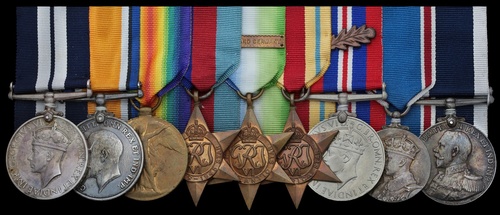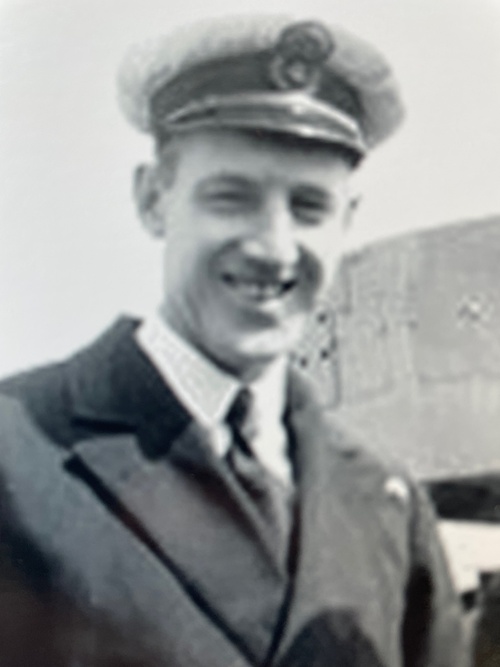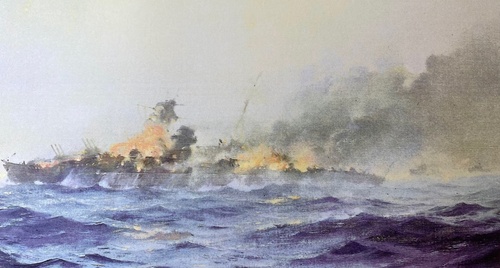Auction: 22002 - Orders, Decorations and Medals
Lot: 193
(x) A fine Scharnhorst action D.S.M. group of nine awarded to Chief Engine Room Artificer F. F. C. Nelmes, Royal Navy, who had earlier won a ‘mention’ for his part in the Battle of Barents Sea
Distinguished Service Medal, G.VI.R. (C.E.R.A. F. F. C. Nelmes, D./M. 6281); British War and Victory Medals (M. 6281 F. F. C. Nelmes Act. E.R.A. 4, R.N.); 1939-45 Star; Atlantic Star, clasp, France and Germany; Africa Star; War Medal 1939-45, with M.I.D. oak leaf; Coronation 1937; Royal Navy L.S. & G.C., G.V.R., 2nd issue, fixed suspension (M. 6281 F. F. C. Nelmes E.R.A. 1, H.M.S. Rodney), the Pair with contact marks and polished, very fine, the remainder better (9)
D.S.M. London Gazette 7 March 1944. The recommendation states:
‘This rating was in the after engine room during the action. When No. 3 dynamo was damaged by shock Nelmes carried out all possible repairs in a quick and efficient manner and set an example of steadiness and keenness to the junior ratings.’
M.I.D. London Gazette 23 February 1943. The recommendation states:
‘He carried out his duty as Chief Engineer Room Artificer of the after engine room with calmness and courage when in action with the enemy.’
Francis Frederick Claud Nelmes was born in Devonport on 12 October 1897, the son of Frederick and Mathilde Nelmes. He enlisted in the Royal Navy as a Boy Artificer on 25 July 1913 and trained at Indus, Fisgard and Vivid II. He joined the Royal Navy on his eighteenth birthday.
In August 1917 Nelmes was drafted to the battleship Malaya, in the 5th Battle Squadron of the Grand Fleet at Scapa Flow. In April 1919 she was at Cherbourg for the peace celebrations. He left the Malaya in October 1919 and was drafted to the destroyer depot ships Greenwich and Columbine, and served in 'V' and 'W' class destroyers for the next five years. In September 1923 he married Stella Gwendoline, née Cook.
From March-November 1925 he was drafted to the light cruiser Chatham. Throughout these years his Ability was graded "Superior" and in May 1925 he was rated E.R.A. 2nd Class. He then returned to Devonport depot and in August 1926 agreed to re-engage until he qualified for a pension. From 1926-29 Nelmes served in three battleships of the Mediterranean Fleet; first, he returned to the Malaya, then he transferred to her sister ship Queen Elizabeth, then another vessel of the same class, the Valiant. In March 1929 the Valiant returned to the UK for refit and Nelmes returned to Devonport.
Nelmes' next ship was the Rodney, which he joined in January 1930. She was a battleship of 35,000 tons, armed with nine 16-inch guns, and was part of the Atlantic Fleet. Nelmes' character had always been assessed as "Very Good" and in October 1930 was awarded his L.S. & G.C. Medal. Nelmes was still serving in the Rodney in September 1931, when her company took part in the mutiny at Invergordon. In response to the Depression, the Government promulgated pay cuts to members of the civil service and armed forces; the cuts were not applied equally, and would have reduced the income of many ratings and petty officers by 25%. Rodney was regarded as the "reddest" ship and some of her men were ring-leaders, including two with the code-names "Trotsky" and "Gandhi." When she was ordered to sea, only 75 men from her company of 1200 reported for duty, and the remainder jeered sailors from other ships who were still working.
In April 1932 Nelmes was drafted to the Warwick, a 'W' class destroyer then in the Reserve Fleet. In September that year he was transferred to the cruiser Norfolk, deployed on the America and West Indies station. Whilst serving in this ship he was rated Chief Engine Room Artificer. Nelmes was transferred to Drake in January 1935 and remained ashore until December 1936, when he joined the battleship Royal Sovereign in the Atlantic Fleet. Having attained the age of forty and completed his period of engagement, Nelmes retired in October 1937.
As war approached, Nelmes was recalled to the Navy on 31 July 1939 and drafted to another 'W' class destroyer, the Witch. Launched in 1919, she was not completed until 1924 and was soon decommissioned and assigned to the reserve. She was recommissioned in 1939 and assigned to the 15th Destroyer Flotilla at Rosyth. The flotilla was then redeployed to the Western Approaches command for duty in the western approaches and North Atlantic. The Witch was deployed in Operation Sickle, the transport of troops from Rosyth to Norway, and was then employed on convoy operations in the North Sea.
From July 1940 to February 1942 Nelmes was at Nemo, an Auxiliary Patrol base at Brightlingsea, in northern Essex. The Auxiliary Patrol consisted of small vessels such as motor launches, motor torpedo boats and air-sea rescue craft. Their duties included the protection of East Coast convoys which were regularly attacked by aircraft and E-boats, and also menaced by mines. In April 1942 Nelmes was loaned to the Caradoc, a 'C' class light cruiser, for passage from Portsmouth (where she had undergone a refit) to Scapa, to join the fleet. He then returned to Plymouth.
On 20 May 1942 Nelmes was drafted to the Jamaica, a Mauritius-class light cruiser built at Barrow. She had been laid down in 1939, launched on 16 November 1940 and was completed in June 1942. She had twelve 6-inch guns, mounted in four turrets of three guns each, and was designed for 33 knots. With twin funnels and masts she looked the part of a fast, modern cruiser.
She arrived at Scapa Flow on 1 July 1942 and began to "work-up" with ships of the Home Fleet. Her first tasks included escort of the Howe from Rosyth to Scapa, providing cover for a mine-laying operation in the North Sea and, from 8-24 September, providing distant cover to convoy PQ-18 to northern Russia, with a diversion to Spitsbergen to support the garrison there.
On 27 October the Jamaica began a passage to Gibraltar, having been nominated to take part in Operation Torch, the Allied landings in North Africa. On 8 November she supported the landing of American forces at Oran and, the following day, she was in action for the first time, repelling a counter-attack by Vichy French destroyers. On the 10th she bombarded coastal batteries. On 14 November she was released from the operation and returned to Scapa Flow.
Battle of the Barents Sea
Towards the end of 1942 the Admiralty adopted the tactic of breaking convoys to Russia into smaller groups. Thus JW51A was the first half of a convoy which reached Kola Inlet on Christmas Day 1942; it was quickly followed by the other half, JW51B. The awful severity of the Arctic weather in winter, it was hoped, would reduce the danger of attacks by U-boats and aircraft.
The convoy, consisting of fourteen merchant ships, was escorted by six destroyers and five smaller warships under the command of Captain R. St V. Sherbrooke in the Onslow. On 27 December the cruisers Sheffield (flying the flag of Rear-Admiral R.L. Burnett) and Jamaica sailed from Kola to meet the convoy. That same day a severe gale struck and partly scattered the ships, although most succeeded in re-joining the convoy.
On 30 December U-354 sighted the convoy to the south of Bear Island and reported its presence. A powerful German squadron sailed from Alten Fjord in Norway to intercept; it consisted of the heavy cruiser Admiral Hipper (flying the flag of Vice Admiral Kummetz), the pocket battleship Lützow and six destroyers. The Hipper was a ship of 12,500 tons, armed with eight 8-inch guns; the Lützow was slightly larger, at 12,750 tons, with a similar armament and the two ships were far more powerful than the two British cruisers.
The German force divided in two to attack the convoy, Hipper from the north and Lützow from the south. Burnett's cruisers had not yet established contact and a day of utter confusion developed in atrocious weather conditions.
At 08:30hrs on the 31st Obdurate reported the presence of strange destroyers to the rear of the convoy. Sherbrooke sent her to investigate, at the same time he sent his own ship's company to breakfast and ordered them to change into clean underclothing. It must have been one of the very few occasions during the Second World War when that traditional order was given. At 09:39hrs Onslow sighted Hipper to the north of the convoy. Over the following hour Onslow and another destroyer skirmished with the cruiser, slipping in and out of the smoke screens and threatening her with their torpedoes. To begin with Hipper's gunnery was uncertain but at around 10:20hrs Onslow was hit several times by 8 inch shells. Within a few minutes the ship was in a critical condition; A and B guns were out of action, the ship was holed in the engineroom, serious fires were raging, and more than forty of her company were dead or wounded. The casualties included Captain Sherbrooke who was hit in the face by a shell splinter and nearly blinded; he refused to leave the bridge until satisfied that the commander of Obedient had taken over from him.
While this battle was in progress Lützow approached the convoy from the south; only the snow squalls which shielded the ships and the timidity of the battleship's captain saved the convoy from annihilation. Again, at around 11:00hrs both the Hipper and Lützow approached the convoy and were held off only by the threat of torpedoes from the hard-pressed destroyers. The destroyer Achates was crippled but continued to fight for another two hours before sinking.
At 11:36hrs the cruisers Sheffield and Jamaica arrived on the scene and opened fire on Hipper, inflicting considerable damage. Two German destroyers, which had been detached to sink the minesweeper Bramble, misidentified the British cruisers for German ships and attempted to form up on them. Sheffield opened fire on the leading ship, the Friedrich Eckholdt, at a range of 4,000 yards; the German commander sent a message to Hipper:
'You are firing on me.'
Astern, the awful truth dawned and the Richard Beitzen sent a hurried message to her flotilla leader:
'No. It is an English cruiser.'
It was too late however, and the Sheffield fired on her with everything from her main 6-inch guns down to her anti-aircraft pom-poms. A Midshipman recalled:
A number of us were permitted to leave the turret and go out on deck to see this dark grey wreck of a vessel a short distance away, some 2-300 yards at most, listing over with her hull exposed and with fires burning at various points along her deck, so slowly passing down our ship's side. The upper deck short-range weapons raked the burning deck with gunfire as she drifted astern of us into the darkness and oblivion. I cannot remember seeing any movement nor signs of life aboard … It was an eerie and to my mind ghostly vision, unreal, as though in a black-and-white film, but the flames already dying as they were, seemed to illustrate the … finality of a gallant foe.'
The Jamaica fired on the Richard Beitzen, which turned away at speed and made her escape undamaged. After further manoeuvring the Hipper and Lutzow gave up and returned to their base. All the merchant ships of the convoy reached port safely; their cargo included 2,046 vehicles, 202 tanks, 87 fighters, 33 bombers, 24,000 tons of fuel and more than 54,000 tons of miscellaneous supplies.
At the beginning of the action, the young commander of U-354 sent a report concluding with the stirring words;
'Watching from this locality the battle has reached its climax. I can see only red!'
In his far-away bunker in East Prussia, Hitler was in the highest state of anticipation, expecting the annihilation of the convoy. Due to a series of mishaps, the German Admiral's report was delayed and, despite a series of increasingly strident demands, Hitler first heard the results of the action from the BBC. Hitler was enraged, stated that the surface fleet was 'utterly useless' and ordered it to be scrapped; in the end he relented, but Admiral Raeder had to resign from command of the German Navy.
For its part, the Admiralty was delighted; As Admiral Sir John Tovey remarked;
'...that an enemy force of at least one pocket battleship, one heavy cruiser and six destroyers with all the advantages of surprise and concentration, should be held off for four hours by five destroyers, and driven from the area by two 6-inch cruisers is most creditable and satisfactory.'
Captain Sherbrooke, who survived his wounds, was awarded the Victoria Cross. Among other decorations, Captain J. L. Storey of the Jamaica was awarded the DSO and seven members of his ship's company, including Nelmes, were 'mentioned'. When submitting the recommendations to the Admiralty, Admiral Tovey noted:
'It is particularly important that the enemy should not get to know the composition of Force 'R', and it is therefore requested that when awards as a result of these recommendations are gazetted, the date or location of the action should not be specified.'
Nelmes was still serving in the Jamaica when, almost a year later, she was again in action against a German battleship which was attacking a Russia-bound convoy. On 20 December 1943 convoy JW55B comprising 19 ships sailed from Loch Ewe in northern Scotland for Russia, via Norway's North Cape. Two days later convoy RA55A of 22 ships left Kola Inlet in northern Russia homeward-bound. Both convoys had close escorts of destroyers. The 10th Cruiser Squadron, the Belfast, Norfolk and Sheffield, under the command of Rear Admiral Bob Burnett, formed a covering force, while distant cover was provided by the battleship Duke of York (35,000 tons, ten 14-inch guns) and the Jamaica, with four destroyers. Admiral Sir Bruce Fraser in Duke of York was in over-all command.
At 4 am on Boxing Day the battle-cruiser Scharnhorst (31,800 tons, nine 11-inch guns and 33 knots) and five destroyers sailed from Alten Fjord in bitter weather and atrocious sea conditions to attack the convoy, which was about 100 miles to her north-west. Burnett's cruiser squadron was 150 miles east of the enemy and Fraser's battle group was about 220 miles south-west of the convoy.
That morning Burnett picked up the Scharnhorst by radar, closed at full speed and opened fire at 13,500 yards. The first salvos struck home and, among other damage, destroyed the battle- cruiser's forward radar installation. Scharnhorst was taken completely by surprise, turned away and escaped in the Arctic darkness. So severe were the conditions that Admiral Bey, the German commander, detached his destroyers and sent them back to base. By contrast, not only did the British destroyers remain at sea, but they also participated fully in the battle that followed.
Burdett guessed that Bey would work around and head for the convoy and acted accordingly. Sure enough, when the Scharnhorst spotted the convoy it was Burnett's cruisers which emerged from the gloom and engaged her for twenty minutes, inflicting more damage. Bey broke off the action and headed south-east - directly towards Fraser's battle group.
The Duke of York's radar picked up the Scharnhorst four hours later at the extreme range of 44,000 yards. She and Jamaica closed the range to 12,000 yards before illuminating their target with starshell. The flares descended slowly, throwing the beautiful ship into a brief, haunting silhouette '...like a great silver ghost of enormous length … it was a gunnery officer's dream come true.'
Her gun turrets, aligned fore and aft, betrayed the extent of her surprise. Broadsides from the two ships ripped into the battle-cruiser inflicting severe damage before she turned away and made off at full speed. The Duke of York and Jamaica pursued but gradually fell behind and despondency set in as it appeared that the Scharnhorst would escape. The destroyers then launched an attack, hitting the battle-cruiser with two torpedoes which reduced her speed to ten knots. The Duke of York and Jamaica caught up and Scharnhorst's doom was sealed. On fire from stem to stern and almost on her beam ends, she finally foundered at about 19:45hrs. With her, unseen in the freezing, spray-sodden night, went Admiral Bey and all but 36 of the ship's company of 1,968 officers and ratings.
The pursuit of the Scharnhorst had required a good deal of steaming at full speed and the utmost exertions of the engine room staff, who were not overlooked in the distribution of decorations after the victory, Nelmes duly adding the D.S.M. to his laurels.
After repairs to battle damage, the Jamaica provided cover to Russian convoys JW57 and JW58 to Russia and the corresponding return convoys. In April 1944 she was part of the escort for the Victorious when her aircraft carried out air strikes against the Tirpitz in Norway (Operation Tungsten). In June she was deployed with the Home Fleet at Scapa to provide distant cover, if required, for the landings in Normandy. The following month she took part in Operation Mascot, in which aircraft from three carriers again attacked the Tirpitz. Jamaica returned to Russia in August 1944 when she escorted JW59. The convoy was also escorted by the Soviet battleship Archangelsk, which Nelmes would have recognised as his old ship the Royal Sovereign (on loan to the Soviets). The cruiser then took part in an operation to resupply the Allied garrison in Spitsbergen.
Nelmes left the Jamaica in September 1944 and served ashore at Drake, Raleigh and Adventure until the end of the war. He was released from the Navy on 27 September 1945 and died at St Budeaux, Plymouth, on 30 August 1960; sold together with copied research including a portrait photograph of the recipient.
Subject to 5% tax on Hammer Price in addition to 20% VAT on Buyer’s Premium.
Sold for
£2,400
Starting price
£2400









